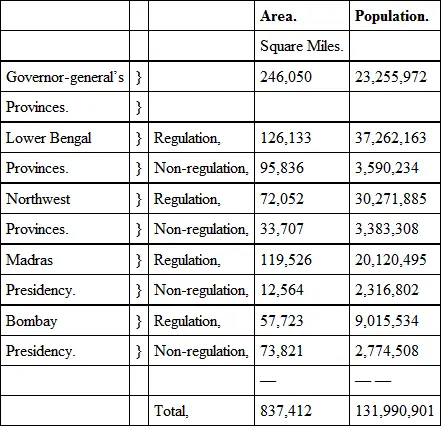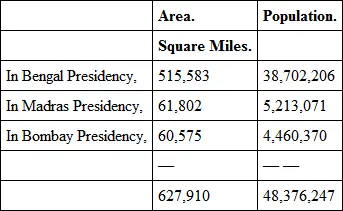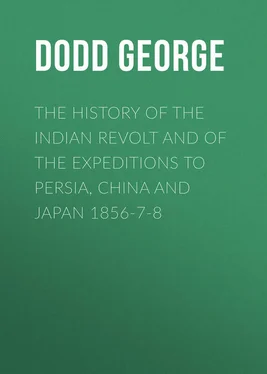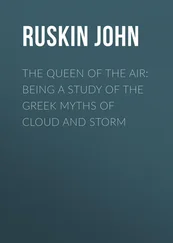George Dodd - The History of the Indian Revolt and of the Expeditions to Persia, China and Japan 1856-7-8
Здесь есть возможность читать онлайн «George Dodd - The History of the Indian Revolt and of the Expeditions to Persia, China and Japan 1856-7-8» — ознакомительный отрывок электронной книги совершенно бесплатно, а после прочтения отрывка купить полную версию. В некоторых случаях можно слушать аудио, скачать через торрент в формате fb2 и присутствует краткое содержание. Жанр: foreign_antique, foreign_prose, на английском языке. Описание произведения, (предисловие) а так же отзывы посетителей доступны на портале библиотеки ЛибКат.
- Название:The History of the Indian Revolt and of the Expeditions to Persia, China and Japan 1856-7-8
- Автор:
- Жанр:
- Год:неизвестен
- ISBN:нет данных
- Рейтинг книги:3 / 5. Голосов: 1
-
Избранное:Добавить в избранное
- Отзывы:
-
Ваша оценка:
- 60
- 1
- 2
- 3
- 4
- 5
The History of the Indian Revolt and of the Expeditions to Persia, China and Japan 1856-7-8: краткое содержание, описание и аннотация
Предлагаем к чтению аннотацию, описание, краткое содержание или предисловие (зависит от того, что написал сам автор книги «The History of the Indian Revolt and of the Expeditions to Persia, China and Japan 1856-7-8»). Если вы не нашли необходимую информацию о книге — напишите в комментариях, мы постараемся отыскать её.
The History of the Indian Revolt and of the Expeditions to Persia, China and Japan 1856-7-8 — читать онлайн ознакомительный отрывок
Ниже представлен текст книги, разбитый по страницам. Система сохранения места последней прочитанной страницы, позволяет с удобством читать онлайн бесплатно книгу «The History of the Indian Revolt and of the Expeditions to Persia, China and Japan 1856-7-8», без необходимости каждый раз заново искать на чём Вы остановились. Поставьте закладку, и сможете в любой момент перейти на страницу, на которой закончили чтение.
Интервал:
Закладка:
While one of these extraordinary marches is in progress, ‘when the moving masses are touched here and there by the reddening light of the dawn, it seems to be a true migration, with flocks and herds, cattle loaded with baggage, men, women, and children, all in a chaos of disorder but the troops whose wants and wishes have attracted this assemblage. At length the country appears to awake from its sleep, and with the yell of the jackal, or the distant baying of the village dogs, are heard to mingle the voices of human beings. Ruddier grows the dawn, warmer the breeze, and the light-hearted sepoy, no longer shivering with cold, gives vent to the joyous feelings of morning in songs and laughter. The scenes become more striking, and the long array of tall camels, led by natives in picturesque costume, with here and there a taller elephant mingling with droves of loaded bullocks, give it a new and extraordinary character to a European imagination. The line of swarthy sepoys of Upper India, with their moustached lips and tall handsome figures, contrasts favourably with the shorter and plainer soldiers of Britain; the grave mechanical movements of the regular cavalry in their light-blue uniforms are relieved by the erratic evolutions and gay and glittering dresses of the irregulars, who with loud cries and quivering spears, and their long black locks streaming behind them, spur backwards and forwards like the wind from mere exuberance of spirits… The camp-followers in the meantime present every possible variety of costume; and among them, and not the least interesting figures in the various groups, may frequently be seen the pet lambs of which the sepoys are so fond, dressed in necklaces of ribbons and white shells, and the tip of their tails, ears, and feet dyed orange colour. The womenkind of the troops of the Peninsula (Southern India) usually follow the drum; but the Bengalees have left their families at home; and the Europeans bidden adieu to their temporary wives with the air the band strikes up on quitting the station, “The girl I left behind me.’” 4 4 Leitch Ritchie. British World in the East.
Such, before the great Revolt, were the usual characteristics of an Anglo-Indian army when on the march; and, considering the impedimenta , it is not surprising that the daily progress seldom exceeded ten or twelve miles. The system was very costly, even at the cheap rate of Indian service; for the camp-followers, one with another, were ten times as numerous as the troops; and all, in one way or other, lived upon or by the Company.
A parliamentary paper, issued in 1857 on the motion of Colonel Sykes, affords valuable information on some of the matters treated in this chapter. It is ‘A Return of the Area and Population of each Division of each Presidency of India, from the Latest Inquiries; comprising, also, the Area and Estimated Population of Native States.’ It separates the British states from the native; and it further separates the former into five groups, according to the government under which each is placed. These five, as indicated in the present chapter, are under the administration of ‘the governor-general of India in council’ – the ‘lieutenant-governor of Bengal’ – the ‘lieutenant-governor of the Northwest Provinces’ – the ‘government of Madras’ – and the ‘government of Bombay.’ In each case the ‘regulation districts’ are treated distinct from the non-regulation provinces,’ the former having been longer under British power, and brought into a more regular system than the latter. Without going again over the long list of names of places, it will suffice to quote those belonging to the group placed immediately under the governor-general’s control. This group comprises the Punjaub, in the six divisions of Lahore, Jelum, Moultan, Leia, Peshawur, and Jullundur; the Cis-Sutlej states, four in number; the lately annexed kingdom of Oude; the central district of Nagpoor or Berar; the recently acquired region of Pegu; the strip of country on the east of the Bay of Bengal, known as the Tenasserim Provinces; and the ‘Eastern Straits Settlements’ of Singapore, Penang, and Malacca. The whole of British India is divided into nearly a hundred and eighty districts, each, on an average, about the size of Inverness-shire, the largest county, except Yorkshire, in the United Kingdom. The population, however, is eight times us dense, per average square mile, as in this Scottish shire. Keeping clear of details concerning divisions and districts, the following are the areas and population in the five great governments:

In some of the five governments, the population is classified more minutely than in others. Thus, in the Punjaub member of the governor-general’s group, Hindoos are separated from non-Hindoos; then, each of these classes is divided into agricultural and non-agricultural; and, lastly, each of these is further separated into male and female. The most instructive feature here is the scarcity of females compared with males, contrary to the experience of Europe; in the Punjaub and Sirhind, among thirteen million souls, there are a million and a half more males than females – shewing, among other things, one of the effects of female infanticide in past years. The ratio appears to be about the same in the Northwest Provinces, around Delhi, Meerut, Rohilcund, Agra, Benares, and Allahabad. Not one place is named, throughout India, in which the females equal the males in number. In the Bombay presidency, besides the difference of sex, the population is tabulated into nine groups – Hindoos, Wild Tribes, Low Castes, Shrawniks or Jains, Lingayets, Mussulmans, Parsees, Jews, Christians. Of the last named there are less than fifty thousand, including military, in a population of twelve millions.
The area and population of the native states are given in connection with the presidencies to which those states are geographically and politically related, and present the following numbers:

The enumeration of these native states is minute and intricate; and it may suffice to shew the complexity arising out of the existence of so many baby-princedoms, that one of the native states of Bundelcund, Kampta by name, figures in the table as occupying an area of one square mile, and as having three hundred inhabitants!
Including the British states, the native states, the few settlements held by the French and Portuguese, and the recent acquisitions on the eastern side of the Bay of Bengal, the grand totals come out in the following numbers:

or 124 dwellers per square mile. Of these inhabitants, it is believed – though the returns are not complete in this particular – that there are fifteen Hindoos to one Mohammedan: if so, then India must contain more than a hundred and sixty million worshippers of Hindoo deities – even after allowance is made for Buddhists, Parsees, and a few savage tribes almost without religion.
CHAPTER II.
SYMPTOMS: – CHUPATTIES AND CARTRIDGES
Little did the British authorities in India suspect, in the early weeks of 1857, that a mighty CENTENARY was about to be observed – a movement intended to mark the completion of one hundred years of British rule in the East; and to mark it, not by festivities and congratulations, but by rebellion and slaughter.
Читать дальшеИнтервал:
Закладка:
Похожие книги на «The History of the Indian Revolt and of the Expeditions to Persia, China and Japan 1856-7-8»
Представляем Вашему вниманию похожие книги на «The History of the Indian Revolt and of the Expeditions to Persia, China and Japan 1856-7-8» списком для выбора. Мы отобрали схожую по названию и смыслу литературу в надежде предоставить читателям больше вариантов отыскать новые, интересные, ещё непрочитанные произведения.
Обсуждение, отзывы о книге «The History of the Indian Revolt and of the Expeditions to Persia, China and Japan 1856-7-8» и просто собственные мнения читателей. Оставьте ваши комментарии, напишите, что Вы думаете о произведении, его смысле или главных героях. Укажите что конкретно понравилось, а что нет, и почему Вы так считаете.












